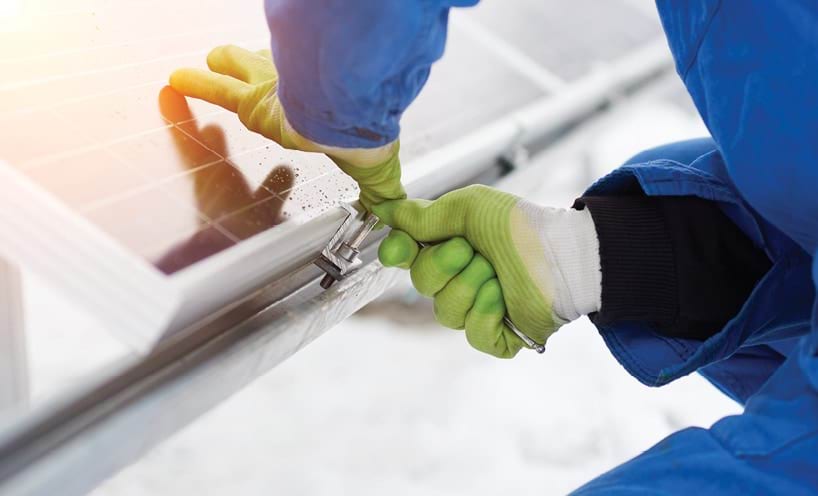Steps to purchase, install and connect a solar battery system at home
Keep in mind the following steps to installing a solar battery system at home:
- Read this Buyers Guide and the Solar Panel (PV) Buyers Guide to learn about solar and battery systems.
- Gather your questions and seek independent advice
- Confirm your own household’s requirements – see the section on Planning Your Solar Battery System
- Confirm battery hosting capability with a Distribution Network Service Provider (DNSP)
- Seek recommendations on retailers that manage installation and then contact those who are appropriately accredited for quotes
- Select your preferred retailer. Make sure the quote meets your needs, using our checklist in this Buyers Guide can help
- Apply for eligibility for a Solar Battery Loan
- Sign a contract with your retailer
- Install your new system
- Connect your battery system to the grid, arranged by your installer
- Enjoy your new energy storage system and reduced energy bills.
Finding a retailer or installer
As with all major purchases, you should carefully consider both price and quality when buying a system.
Solar Savvy Tip: Always get at least three quotes from New Energy Tech Approved Sellers for the same size system. Note that a quality system offering a long and useful life may cost more and be more worthwhile.
New Energy Tech Approved Sellers
Solar PV and battery retailers in the Solar Homes Program must fulfil our requirements, including being a New Energy Tech (NET) Approved Seller.
This means they have committed to high standards across sales and marketing, quotes and contracts, delivery and installation, and warranties and support.
Customers doing business with a NET Approved Seller can be confident they are getting clear, honest information, quality installation, and good warranties.
Check the NETCC website for a list of NET Approved Sellers in your area and our list of authorised solar retailers to see if they are participating in our program. Also look into websites that can make it easier to obtain multiple quotes without having to ring around.
For more information about what we require of retailers in our program, see Consumer protection.
Accredited installers
The person who installs your system also needs to hold accreditation with battery endorsement, and must hold an unrestricted Class A Electrical Licence registered with Energy Safe Victoria.
A good installer will help you plan the right system to suit your household now and into the future. They will recommend the best position to install your system to generate as much electricity as possible.
For more information about what we require of installers in our program, see Consumer protection.
Consider how system faults will be handled
A warranty is only as good as the company that provides it. If the company disappears in a few years, you might have difficulty making a warranty claim should faults or failures occur. It’s not possible to know the future of any solar or battery system manufacturer or installer, as some of the biggest players over the years have simply disappeared. Seeking out a retailer or installer with a long history in the business helps.
Also, be aware that under Australian Consumer Law, warranties are required to be honoured by product manufacturers even if the local retailer has gone out of business, so make sure you receive and keep information about the manufacturers of all the different components of your system, and the different warranties on each component.
What not to do when engaging an installer or company
Installing a solar battery system is something that you want to get right: after all, you only get one shot at the rebate, and a well-installed system with quality parts can continue to save you money for many years to come. A poorly-installed system or one with cheap components can be nothing but trouble.
Don’t buy a solar battery system from a door-to-door salesperson, or from a salesperson who cold calls you on the phone. If you have signed a contract in this way, take advantage of the 10-day cooling off period under consumer law to cancel the contract, and then take your time to do your homework, plan your system and find a quality battery installer.
Do not make any payment to a solar battery provider until your eligibility has been confirmed by Solar Victoria. Learn how to apply for eligibility for a solar battery loan.

Solar scams
Solar scams do exist unfortunately, with offers too good to be true.
If you are the target of a scam, please report it to the Australian Competition and Consumer Commission (ACCC) via the SCAMwatch website or by calling 1300 795 995.
Do I need approval from the electricity distributor to install a battery?
Your installer will manage the grid connection process for you. The process is often straightforward, although additional time or fees may apply when connecting larger systems.
To connect a solar or solar battery system to the grid, your installer applies to your local electricity distributor. A rooftop solar system always requires application approval from the electricity distributor.
If you are installing a battery with solar, it will be managed by your installer as part of the same approval process. If a battery is retrofitted to an existing solar PV system, an amendment to the connection agreement is required.
Check the exact requirements with your installer and/or electricity distributor.
Installer and quotation checklist, including tips for evaluating quotes
Grid-connected batteries for solar battery systems are relatively new. None of the currently available products in the Australian market have been around for more than about five years. Consider the following advice when buying a grid-connected battery, either as part of a solar battery system or on its own.
- Get at least three quotes of roughly the same system size and functionality. That way you can compare ‘apples with apples’.
- Make sure the installer is an A Grade electrician, holds accreditation with battery endorsement, and that the company is a Solar Victoria Authorised Solar Retailer.
- Inform yourself. Given grid-connected batteries are relatively new, have a look on some web based consumer forums to see feedback about specific products such as the Whirlpool forums. The Lithium Ion Battery Test Centre compares various chemistries and products available in the Australian market against claims made by manufacturers.
- Confirm with your DNSP the ability of your property to connect a battery to the grid.
- Ask your retailer to conduct a cost-benefit analysis, taking into account your current or soon to be installed solar panel system, energy usage profile and product capability.
- Make sure you have thought about your sizing needs.
- What size do you need?
- What is this based on? For example, optimal economic size, achieving 90 per cent grid independence, etc.
- Do you want the battery to work as a backup when the grid goes down?
- Do you want to be able to charge the battery from the grid?
- Do you want the system to optimise how much energy to purchase from the grid by predicting tomorrow’s solar generation?
- Do you want to be able to sell electricity from the battery back to the grid?
- Where will the battery be installed? Does this comply with the manufacturer’s requirements and appropriate standards set out in the Best Practice Guide20?
- What is the monitoring system? How will you be able to access performance data from the battery? E.g. smart phone app. What type of data will be provided?
- Ask the retailer for customer references. Talk to previous customers about the process and how their projects performed?
- Does the system require maintenance? If so, who will do this, when and how?
- Are parts readily available? Does the manufacturer have an Australian office?
- What are the performance guarantees and warranties for the system?
- Are there specific exclusions or operational conditions (e.g. location, temperature range) for the warranty to remain valid?
- What is the total number of cycles warranted for the battery?
- How many years does this correspond to at your required cycles, taking into account depth of discharge?
- Which warranties are the retailer’s responsibility and which are the manufacturer’s? (Usually the component warranties are the responsibility of the manufacturer, while the installation warranty resides with the retailer or Australian supplier. Ultimately however, under Australian Consumer Law, the importer of the components into Australia has primary responsibility for product warranties.)
- What is the design life of the battery?
- Given all batteries reduce in capacity over their lifespans, what will be the useable kilowatt-hours at/near the end of its life, for example, in year 10?

What to look for in a solar quote
This article will help you understand what to look for in a quote so you can make an informed decision when buying rooftop solar for your home.
This Buyers Guide was developed in conjunction with Renew. All photos have been supplied with permission and are subject to copyright. Please contact comms@team.solar.vic.gov.au regarding permissions for use of content and images.
Updated



